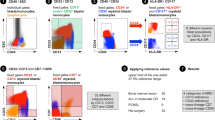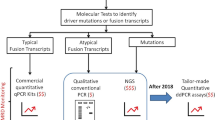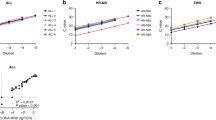Abstract
A certain quantity of residual leukemic cells at several time points during chemotherapy of childhood acute lymphoblastic leukemia (ALL) was proved to predict outcome. Future childhood ALL treatment will take minimal residual disease (MRD) into consideration for stratification aiming at an individualization of chemotherapeutic regimens. Recently, the first quantitative real-time PCR assay for MRD detection was described using T cell receptor and immunoglobulin gene rearrangements as clonal markers. Quantitative real-time PCR was performed with TaqMan technology. Here, we present for the first time the potential of LightCycler real-time PCR technology to quantify MRD. We compare and assess different approaches for real-time PCR quantification of leukemic cells, based either on clone-specific primers and general fluorescence detection with SYBR Green, TaqMan probe or hybridization probes, or based on general PCR amplification and clone-specific detection with hybridization probes. MRD quantification with LightCycler real-time PCR technology is a sensitive, specific and incomparably rapid method that needs no post-PCR handling, hence eliminating contamination risk and saving time. Working towards the establishment of MRD quantification in routine diagnostics and towards treatment strategies based on these results, LightCycler quantitative PCR seems to be a promising new technique that makes results immediately available for treatment decisions.
This is a preview of subscription content, access via your institution
Access options
Subscribe to this journal
Receive 12 print issues and online access
$259.00 per year
only $21.58 per issue
Buy this article
- Purchase on Springer Link
- Instant access to full article PDF
Prices may be subject to local taxes which are calculated during checkout





Similar content being viewed by others
References
Cave H, van der Werff ten Bosch J, Suciu S, Guidal C, Waterkeyn C, Otten J, Bakkus M, Thielemans K, Grandchamp B, Vilmer E . Clinical significance of minimal residual disease in childhood acute lymphoblastic leukemia. European Organization for Research and Treatment of Cancer – Childhood Leukemia Cooperative Group (see comments) New Engl J Med 1998 339: 591–598
van Dongen JJ, Seriu T, Panzer Grumayer ER, Biondi A, Pongers-Willemse MJ, Corral L, Stolz F, Schrappe M, Masera G, Kamps WA, Gadner H, van Wering ER, Ludwig WD, Basso G, de Bruijn MA, Cazzaniga G, Hettinger K, van der Does van den Berg A, Hop WC, Riehm H, Bartram CR . Prognostic value of minimal residual disease in acute lymphoblastic leukaemia in childhood Lancet 1998 352: 1731–1738
Biondi A, Yokota S, Hansen Hagge TE, Rossi V, Giudici G, Maglia O, Basso G, Tell C, Masera G, Bartram CR . Minimal residual disease in childhood acute lymphoblastic leukemia: analysis of patients in continuous complete remission or with consecutive relapse Leukemia 1992 6: 282–288
Brisco MJ, Condon J, Hughes E, Neoh SH, Sykes PJ, Seshadri R, Toogood I, Waters K, Tauro G, Ekert H et al. Outcome prediction in childhood acute lymphoblastic leukaemia by molecular quantification of residual disease at the end of induction (see comments) Lancet 1994 343: 196–200
Knechtli CJ, Goulden NJ, Hancock JP, Harris EL, Garland RJ, Jones CG, Grandage VL, Rowbottom AW, Green AF, Clarke E, Lankester AW, Potter MN, Cornish JM, Pamphilon DH, Steward CG, Oakhill A . Minimal residual disease status as a predictor of relapse after allogeneic bone marrow transplantation for children with acute lymphoblastic leukaemia Br J Haematol 1998 102: 860–871
van Dongen JJ, Szczepanski T, de Bruijn MA, van den Beemd MW, de Bruin Versteeg S, Wijkhuijs JM, Tibbe GJ, van Gastel Mol EJ, Groeneveld K, Hooijkaas H . Detection of minimal residual disease in acute leukemia patients Cytok Mol Ther 1996 2: 121–133
Sczepanski TBA, Pongers-Willemse MJ, Hählen K, Van Wering ER, Wijkhuijs AJM, Tibbe GJM, De Bruijn MAC, Van Dongen JJM . Cross-lineage T cell receptor gene rearrangements occur in more than ninety percent of childhood precursor-B acute lymphoblastic leukemias: alternative PCR targets for detection of minimal residual disease Leukemia 1999 13: 196–205
Seriu T, Erz D, Stark Y, Bartram CR . T cell receptor Dδ2 Dδ3 rearrangement: a suitable allele-specific marker for the detection of minimal residual disease in childhood acute lymphoblastic leukemia Leukemia 1997 11: 759–761
Ouspenskaia MVJD, Roberts WM, Estrov Z, Zipf TF . Accurate quantitation of residual B-precursor acute lymphoblastic leukemia by limiting dilution and a PCR-based detection system: a description of the method and the principles involved Leukemia 1995 9: 321–328
Sykes PJNS, Brisco MJ, Hughes E, Condon J, Morley AA . Quantitation of targets of PCR by use of limiting dilution Biotechniques 1992 13: 444–449
Cave H, Guidal C, Rohrlich P, Delfau MH, Broyart A, Lescoeur B, Rahimy C, Fenneteau O, Monplaisir N, d'Auriol L et al. Prospective monitoring and quantitation of residual blasts in childhood acute lymphoblastic leukemia by polymerase chain reaction study of delta and gamma T-cell receptor genes Blood 1994 83: 1892–1902
Pongers-Willemse MJ, Verhagen OJ, Tibbe GJ, Wijkhuijs AJ, de Haas V, Roovers E, van der Schoot CE, van Dongen JJ . Real-time quantitative PCR for the detection of minimal residual disease in acute lymphoblastic leukemia using junctional region specific TaqMan probes Leukemia 1998 12: 2006–2014
Heid CA, Stevens J, Livak KJ, Williams PM . Real time quantitative PCR Genome Res 1996 6: 986–994
Mensink E, van de Locht A, Schattenberg A, Linders E, Schaap N, Geurts van Kessel A, De Witte T . Quantitation of minimal residual disease in Philadelphia chromosome positive chronic myeloid leukaemia patients using real-time quantitative RT-PCR Br J Haematol 1998 102: 768–774
Kreuzer KA, Lass U, Bohn A, Landt O, Schmidt CA . LightCycler Technology for the quantification of bcr/abl fusion transcripts Cancer Res 1999 59: 3171–3174
Taube T, Seeger K, Beyermann B, Hanel C, Duda S, Linderkamp C, Henze G . Multiplex PCR for simultaneous detection of the most frequent T cell receptor-delta gene rearrangements in childhood ALL Leukemia 1997 11: 1978–1982
Ririe KM, Rasmussen RP, Wittwer CT . Product differentiation by analysis of DNA melting curves during the polymerase chain reaction Anal Biochem 1997 245: 154–160
Wittwer CT, Herrmann MG, Moss AA, Rasmussen RP . Continuous fluorescence monitoring of rapid cycle DNA amplification Biotechniques 1997 22: 130–131
Holland PM, Abramson RD, Watson R, Gelfand DH . Detection of specific polymerase chain reaction product by utilizing the 5′–3′ exonuclease activity of Thermus aquaticus DNA polymerase Proc Natl Acad Sci USA 1991 88: 7276–7280
Caplin BERR, Bernard PS, Wittwer CT . The most direct way to monitor PCR amplification and mutation detection Biochemica 1999 1: 5–8
De Silva DRA, Herrmann M, Tabiti K, Wittwer C . Rapid geno-typing and quantification on the LightCycler with hybridization probes Biochemica Information 1998 102: 9–12
Acknowledgements
This work was kindly supported by the Deutsche Leukämie Forschungshilfe (DLFH) Germany, and by TIB MOLBIOL, Berlin. We thank Claudia Hanel, Gabriele Schmitt and Lucia Badiali for expert technical assistance, for the committed support.
Author information
Authors and Affiliations
Rights and permissions
About this article
Cite this article
Eckert, C., Landt, O., Taube, T. et al. Potential of LightCycler technology for quantification of minimal residual disease in childhood acute lymphoblastic leukemia. Leukemia 14, 316–323 (2000). https://doi.org/10.1038/sj.leu.2401655
Received:
Accepted:
Published:
Issue Date:
DOI: https://doi.org/10.1038/sj.leu.2401655
Keywords
This article is cited by
-
Long-term fenofibrate treatment impaired glucose-stimulated insulin secretion and up-regulated pancreatic NF-kappa B and iNOS expression in monosodium glutamate-induced obese rats: Is that a latent disadvantage?
Journal of Translational Medicine (2011)
-
Coordinate expression of the human pregnancy-specific glycoprotein gene family during induced and replicative senescence
Biogerontology (2009)
-
Detection of minimal residual disease in hematologic malignancies by real-time quantitative PCR: principles, approaches, and laboratory aspects
Leukemia (2003)
-
Comparison between TaqMan and LightCycler technologies for quantification of minimal residual disease by using immunoglobulin and T-cell receptor genes consensus probes
Leukemia (2003)
-
IMGT® databases, web resources and tools for immunoglobulin and T cell receptor sequence analysis, http://imgt.cines.fr
Leukemia (2003)



